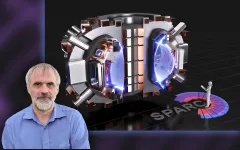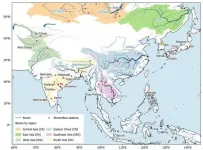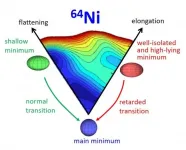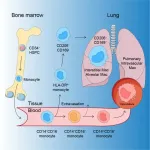Novel public-private partnership facilitates development of fusion energy
2021-01-02
(Press-News.org) The U.S. Department of Energy's (DOE) Princeton Plasma Physics Laboratory (PPPL) is collaborating with private industry on cutting-edge fusion research aimed at achieving commercial fusion energy. This work, enabled through a public-private DOE grant program, supports efforts to develop high-performance fusion grade plasmas. In one such project PPPL is working in coordination with MIT's Plasma Science and Fusion Center (PSFC) and Commonwealth Fusion Systems, a start-up spun out of MIT that is developing a tokamak fusion device called "SPARC."
The goal of the project is to predict the leakage of fast "alpha" particles produced during the fusion reactions in SPARC, given the size and potential misalignments of the superconducting magnets that confine the plasma. These particles can create a largely self-heated or "burning plasma" that fuels fusion reactions. Development of burning plasma is a major scientific goal for fusion energy research. However, leakage of alpha particles could slow or halt the production of fusion energy and damage the interior of the SPARC facility.
New superconducting magnets
Key features of the SPARC machine include its compact size and powerful magnetic fields enabled by the ability of new superconducting magnets to operate at higher fields and stresses than existing superconducting magnets. These features will enable design and construction of smaller and less-expensive fusion facilities, as described in recent publications by the SPARC team -- assuming that the fast alpha particles created in fusion reactions can be contained long enough to keep the plasma hot.
"Our research indicates that they can be," said PPPL physicist Gerrit Kramer, who participates in the project through the DOE Innovation Network for Fusion Energy (INFUSE) program. The two-year-old program, which PPPL physicist Ahmed Diallo serves as deputy director, aims to speed private-sector development of fusion energy through partnerships with national laboratories.
Well-confined
"We found that the alpha particles are indeed well confined in the SPARC design," said Kramer, coauthor of a paper in the Journal of Plasma Physics that reports the findings. He worked closely with the lead author Steven Scott, a consultant to Commonwealth Fusion Systems and former long-time physicist at PPPL.
Kramer used the SPIRAL computer code developed at PPPL to verify the particle confinement. "The code, which simulates the wavy pattern, or ripples, in a magnetic field that could allow the escape of fast particles, showed good confinement and lack of damage to the SPARC walls," Kramer said. Moreover, he added, "the SPIRAL code agreed well with the ASCOT code from Finland. While the two codes are completely different, the results were similar."
The findings gladdened Scott. "It's gratifying to see the computational validation of our understanding of ripple-induced losses," he said, "since I studied the issue experimentally back in the early 1980s for my doctoral dissertation."
Fusion reactions combine light elements in the form of plasma -- the hot, charged state of matter composed of free electrons and atomic nuclei, or ions, that comprises 99 percent of the visible universe -- to generate massive amounts of energy. Scientists around the world are seeking to create fusion as a virtually unlimited source of power for generating electricity.
Key guidance
Kramer and colleagues noted that misalignment of the SPARC magnets will increase the ripple-induced losses of fusion particles leading to increased power striking the walls. Their calculations should provide key guidance to the SPARC engineering team about how well the magnets must be aligned to avoid excessive power loss and wall damage. Properly aligned magnets will enable studies of plasma self-heating for the first time and development of improved techniques for plasma control in future fusion power plants.
INFORMATION:
Support for this research comes from Commonwealth Fusion Systems. Support for Kramer comes from the DOE Office of Science INFUSE program. Contributors to the project include physicists from PSFC; Aalto University in Espoo, Finland; and Chalmers University of Technology in Gothenburg, Sweden.
PPPL, on Princeton University's Forrestal Campus in Plainsboro, N.J., is devoted to creating new knowledge about the physics of plasmas -- ultra-hot, charged gases -- and to developing practical solutions for the creation of fusion energy. The Laboratory is managed by the University for the U.S. Department of Energy's Office of Science, which is the single largest supporter of basic research in the physical sciences in the United States and is working to address some of the most pressing challenges of our time. For more information, visit energy.gov/science
[Attachments] See images for this press release:

ELSE PRESS RELEASES FROM THIS DATE:
2021-01-02
In a first-of-its-kind study within cycad horticulture literature, University of Guam researchers have found that the use of anti-transpirants neither help nor hinder successful propagation of cycad stem cuttings.
The Guam-based study, published Oct. 22 in the journal Tropical Conservation Science, investigated whether retaining leaves during the propagation of cycad stem cuttings conferred any benefit to propagation success. Additionally, two anti-transpirant products were utilized to investigate their efficacy during the propagation process.
Leaves perform a variety of critical functions for plants, including ...
2021-01-02
813 years of annual river discharge at 62 stations, 41 rivers in 16 countries, from 1200 to 2012. That is what researchers at the Singapore University of Technology and Design (SUTD) produced after two years of research in order to better understand past climate patterns of the Asian Monsoon region.
Home to many populous river basins, including ten of the world's biggest rivers (Figure 1), the Asian Monsoon region provides water, energy, and food for more than three billion people. This makes it crucial for us to understand past climate patterns so that we can better predict long term changes in ...
2021-01-02
COLUMBUS, Ohio - The introduction of computer simulation to the identification of symptoms in children with attention deficit/hyperactivity disorder (ADHD) has potential to provide an additional objective tool to gauge the presence and severity of behavioral problems, Ohio State University researchers suggest in a new publication.
Most mental health disorders are diagnosed and treated based on clinical interviews and questionnaires - and, for about a century, data from cognitive tests has been ...
2021-01-02
Kraków, 30 December 2020
The map of nuclear deformation takes the form of a mountain landscape
Until recently, scientists believed that only very massive nuclei could have excited zero-spin states of increased stability with a significantly deformed shape. Meanwhile, an international team of researchers from Romania, France, Italy, the USA and Poland showed in their latest article that such states also exist in much lighter nickel nuclei. Positive verification of the theoretical model used in these experiments allows describing the properties of nuclei unavailable in Earth laboratories.
More than ...
2021-01-02
New Orleans, LA - Research conducted at LSU Health New Orleans Neuroscience Center of Excellence reports that a combination of an LSU Health-patented drug and selected DHA derivatives is more effective in protecting brain cells and increasing recovery after stroke than a single drug. The findings are published in Brain Circulation, available here.
Nicolas Bazan, MD, PhD, Boyd Professor, Professor of Neurology and Director of the Neuroscience Center of Excellence at LSU Health New Orleans School of Medicine, and Ludmila ...
2021-01-02
In some cases, immune cells in the lungs can contribute to worsening a virus attack. In a new study, researchers at Karolinska Institutet in Sweden describe how different kinds of immune cells, called macrophages, develop in the lungs and which of them may be behind severe lung diseases. The study, which was published in Immunity, may contribute to future treatments for COVID-19, among other diseases.
The structure of the lungs exposes them to viruses and bacteria from both the air and the blood. Macrophages are immune cells that, among other things, protect the lungs from such attacks. ...
2021-01-02
East Hanover, NJ. December 30, 2020. A team of rehabilitation researchers has studied processing speed deficits in individuals with spinal cord injury (SCI), comparing their brain activation patterns with those of healthy age-matched controls, and older healthy individuals. They found that the SCI group and older controls had similar activation patterns, but the SCI group differed significantly from their age-matched controls.
The article, "The neural mechanisms underlying processing speed deficits in individuals who have sustained a spinal cord injury: A pilot study" (doi: 10.1007/s10548-020-00798-x) was ...
2021-01-02
BOSTON -- A peer-reviewed paper published in The New England Journal of Medicine provides data from the much-anticipated COVE study, which evaluated mRNA-1273, a vaccine candidate against COVID-19 manufactured by Moderna, Inc. Results from the primary analysis of the study, which will continue for two years, provide evidence that the vaccine can prevent symptomatic infection. Among the more than 30,000 participants randomized to receive the vaccine or a placebo, 11 of those in the vaccine group developed symptomatic COVID-19 compared to 185 participants who received the placebo, demonstrating 94.1 percent efficacy in preventing symptomatic COVID-19. Cases ...
2021-01-02
December 30, 2020 - As the COVID-19 pandemic emerged, trauma centers faced unprecedented obstacles to providing care for injured patients. A look at steps taken by trauma centers in response to COVID-19 is provided by a survey in the January/February Journal for Healthcare Quality (JHQ), the peer-reviewed journal of the National Association for Healthcare Quality (NAHQ). The journal is published in the Lippincott portfolio by Wolters Kluwer.
Trauma centers introduced new processes to optimize use of personal protective equipment (PPE), ICU beds, ventilators, and other limited resources, according to the report by David Bar-Or, MD, of ION Research, Englewood, Colo., ...
2021-01-02
WHAT:
The investigational vaccine known as mRNA-1273 was 94.1% efficacious in preventing symptomatic coronavirus disease 2019 (COVID-19), according to preliminary results from a Phase 3 clinical trial reported in the New England Journal of Medicine. The vaccine also demonstrated efficacy in preventing severe COVID-19. Investigators identified no safety concerns and no evidence of vaccine-associated enhanced respiratory disease (VAERD).
The vaccine was co-developed by Moderna, Inc., a biotechnology company based in Cambridge, Massachusetts, and the National Institute of Allergy and Infectious Diseases (NIAID), part of the National Institutes ...
LAST 30 PRESS RELEASES:
[Press-News.org] Novel public-private partnership facilitates development of fusion energy






